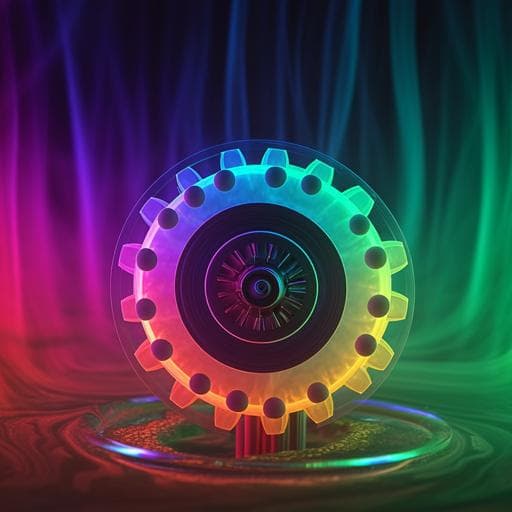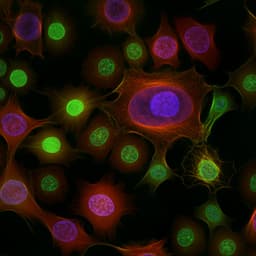
Chemistry
Synergistic interplay between photoisomerization and photoluminescence in a light-driven rotary molecular motor
R. Toyoda, N. V. Hoang, et al.
Discover the groundbreaking research by Ryojun Toyoda and colleagues on a revolutionary light-driven rotary molecular motor that integrates an efficient photoluminescent dye. This innovative system showcases remarkable rotary motion and dazzling photoluminescence, with capabilities for motion and location tracking through unique wavelength tunability.
~3 min • Beginner • English
Introduction
The study addresses how to integrate and control two light-driven functions—rotary motion and photoluminescence—within a single molecular system without mutual detriment. Light-driven rotary molecular motors (MMs) perform unidirectional 360-degree rotation via sequential photoisomerization and thermal helix inversion, operating in diverse environments and promising nanoscale mechanical manipulation. Simultaneously, bright photoluminescent dyes like BODIPY enable optical tracking and imaging. The core question is whether a hybrid molecule can retain efficient motor rotation while exhibiting strong, controllable photoluminescence, and how environmental factors (e.g., solvent polarity) and excitation wavelength can tune or decouple these functionalities. The work proposes a molecular design linking a BODIPY dye to a second-generation overcrowded-alkene motor with minimal conjugation, aiming for moderate interactions that enable synergistic effects such as lower-energy (visible) activation of rotation and chirality transfer for chiroptical control and imaging.
Literature Review
Prior work established diverse photoactive molecules for actuation, catalysis, pharmacology, and luminescence. Feringa-type rotary molecular motors have been optimized and demonstrated in solutions, aqueous media, liquid crystals, on surfaces, and in solid-state frameworks, enabling applications in artificial muscles and materials actuation. BODIPY dyes are known for high photoluminescence quantum yields, narrow bands, large extinction coefficients, and photostability, making them standard imaging probes emitting in the green region, with minimal spectral overlap with motor absorption (reducing energy transfer). Strategies for combining photoswitches and fluorophores have been explored (e.g., diarylethenes and azobenzenes), including energy-transfer-driven motor activation and CPL materials, but simultaneous, orthogonally addressable motor rotation and bright PL in a single covalent hybrid with controlled interplay remains challenging. Solvent effects on motor isomerization kinetics and photophysics are significant, motivating investigation of polarity-dependent competition between PL and isomerization pathways.
Methodology
- Molecular design and synthesis: A second-generation overcrowded alkene motor was covalently linked at the meso-position of a BODIPY dye, engineered to be nearly perpendicular to suppress direct π-conjugation while allowing moderate interaction. Synthesis proceeded via brominated motor precursor (M1) to aldehyde (M2), condensation with 2,4-dimethylpyrrole to dipyrrin (M3), and BF2 complexation to form BODIPY/Motor. Recrystallization yielded single crystals for X-ray diffraction.
- Structural characterization: 1H NMR spectroscopy, high-resolution mass spectrometry, and single-crystal X-ray crystallography (thermal ellipsoids at 50% probability). The dihedral between BODIPY plane and motor upper-half naphthalene was ~87.6°.
- Photochemical/thermal isomerization: Monitored by 1H NMR at low temperature (acetone-d6, −40 °C) under 395 nm LED irradiation to reach photostationary state (PSS), followed by thermal helix inversion (THI) tracking.
- Steady-state spectroscopy: UV/vis absorption and PL spectra recorded for BODIPY/Motor and references (bare motor, bare BODIPY) in solvents (acetone, toluene, THF). Excitations included 395 nm and 505 nm LED irradiations for absorption changes; PL excited at 488 or 510 nm. Stokes shifts and PL quantum yields (PLQY) determined; photoisomerization quantum yields (QY) measured under 390–395 nm and 365/535 nm as noted.
- Solvent dependence: Compared apolar (toluene) vs polar (acetone) solvents to quantify isomerization QY and PLQY; visual PL under 365 nm documented across solvents.
- Time-resolved spectroscopy: Time-resolved photoluminescence using a streak camera with Ti:sapphire laser (400 or 510 nm excitation), pulse picking to 2 MHz for >2 ns windows, magic-angle polarization, and PL maps integrated over 520–600 nm. Femtosecond transient absorption (TA) was also used to confirm ultrafast dynamics.
- Chiroptical measurements: Circular dichroism (CD) spectroscopy on enantiopure R- and S-BODIPY/Motor before and after reaching PSS with 395 nm irradiation, monitoring induced CD and helicity inversion over time/temperature (5 °C to 30 °C).
- Quantum chemical calculations: Ground-state geometries optimized with ωB97X-D/cc-pVDZ and C-PCM (acetone ε=20.7; toluene ε=2.38). Excited states S1 and S2 characterized via spin-flip TDDFT (B5050LYP/cc-pVDZ) in gas phase and solvents. Natural transition orbitals (NTOs) computed for assignment. Potential energy surfaces (PES) along motor axle (Ø1) and BODIPY torsion (Ø2) explored; relaxed scans on S0 and S1; minimum-energy conical intersections (MECPs) S2/S1 and S1/S0 located with penalty function algorithm. Spectral simulations generated by convolution with experimental FWHM.
Key Findings
- Successful hybridization: The BODIPY/Motor retains two distinct absorption bands corresponding to BODIPY (~500 nm) and motor (~390 nm), with slight bathochromic shift vs BODIPY alone, indicating weak intramolecular interaction and preserved functions.
- Motor rotation preserved and efficient: Under 395 nm irradiation in acetone, the stable isomer converts to the metastable isomer reaching PSS in ~20 min with stable:metastable ratio 4:96, followed by THI to complete 180° rotation; cycling reversible without notable degradation.
- Solvent-controlled trade-off between rotation and PL: Photoisomerization QY of BODIPY/Motor is 12% in toluene and increases to 22% in acetone; conversely, PLQY drops from 54% (toluene) to 2.6% (acetone). Stokes shifts remain ~0.051–0.055 eV. BODIPY/Motor PL originates from BODIPY and is broader in acetone.
- Visible-light-driven rotation: Green light (≈505 nm), exciting predominantly the BODIPY S1 band, also drives motor photoisomerization with similar spectral changes as 395 nm, despite bare motor lacking significant absorption at these wavelengths, evidencing a synergistic pathway via S1.
- Excited-state dynamics: BODIPY alone shows PL lifetimes 4.8–5.3 ns (solvent-independent). Upon motor attachment, PL lifetime shortens to ~2.4–2.6 ns in toluene and becomes bi-exponential in acetone with a fast ~17 ps component, indicating accelerated nonradiative depopulation correlating with higher isomerization QY. Average PL lifetime decreases exponentially with solvent polarity index (from ~2.6 ns in toluene to ~0.1 ns in acetonitrile), with no viscosity correlation.
- Theoretical mechanism: PES mapping shows 395 nm excites S2 followed by internal conversion (CI S2/S1) within the FC region to S1, then progression toward CI S1/S0 along the motor Ø1 coordinate enabling isomerization. Under 505 nm, direct S1 excitation relaxes toward CI S1/S0 along BODIPY Ø2 (butterfly) motion with a small barrier (~0.05 eV in acetone), opening a radiationless decay channel competing with PL. A key S1 barrier along Ø1 is lower in acetone (0.09 eV) than toluene (0.23 eV), rationalizing higher isomerization QY and lower PLQY in polar solvent. Thermal interconversion on S0 is excluded by a 1.6 eV barrier.
- Chiroptical synergy: CD spectra reveal induced chirality in the achiral BODIPY arising from the chiral motor, with light-driven inversion of induced CD sign upon photoisomerization, demonstrating helicity control.
- Spectroscopic specifics: BODIPY/Motor absorption/PL peaks: toluene ~508/519 nm (PLQY 54%); acetone ~503/513 nm (PLQY 2.6%). Motor absorption ~389 nm (toluene) and ~386 nm (acetone).
Discussion
The hybrid design achieves orthogonal-yet-interacting photofunctions: BODIPY provides bright emission for localization and readout, while the motor retains unidirectional rotation. Moderate intramolecular interaction enables energy flow on the excited-state landscape such that excitation into BODIPY (S1) can funnel toward the motor’s isomerization coordinate via conical intersections, permitting green-light activation that is advantageous for biological and soft-matter contexts. The competition between PL and photoisomerization is governed by the accessibility of CI S1/S0 and the barrier heights on S1; solvent polarity stabilizes the S1 and CI regions, lowering the barrier along the isomerization path in polar media, thereby biasing the outcome toward rotation at the expense of PL. Time-resolved measurements corroborate the theoretical picture, linking shorter PL lifetimes (and ultrafast components) with enhanced isomerization efficiency. Chiroptical measurements confirm chirality transfer and light-addressable helicity inversion in the dye moiety, expanding the functional scope to circularly polarized light control and potential chiral imaging modalities.
Conclusion
A covalent BODIPY–second-generation motor hybrid was realized that simultaneously supports efficient rotary motion and bright photoluminescence. The balance between these functions is tunable by excitation wavelength (including green-light activation) and solvent polarity. Synergistic interactions allow lower-energy excitation to drive rotation and enable chirality transfer from the motor to the dye with light-controllable helicity. Quantum chemical analysis identifies conical intersection-mediated pathways and solvent-dependent S1 barriers as determinants of the PL–isomerization competition, validated by time-resolved PL and TA. This work provides a strategy for designing multifunctional photoactive molecular machines that combine actuation with optical tracking and chiroptical control. Future research may pursue: quantitative control of function partitioning via structural tuning, explicit solvent and environment design (e.g., biomimetic media, polymers), integration into materials and devices, exploration of circularly polarized excitation/readout, and expansion to red/NIR-absorbing dyes for deeper-tissue applications.
Limitations
Theoretical modeling employed an implicit solvent (C-PCM), which may not capture explicit solvent–solute interactions affecting the energetics and accessibility of conical intersections; discrepancies were noted in relative CI energetics between acetone and toluene. Calculated absorption/emission bands were blue-shifted relative to experiment, consistent with TDDFT error margins. In polar solvents, PLQY is strongly reduced, which could limit imaging brightness under conditions favoring rotation; optimizing structure–environment interplay to mitigate this trade-off remains to be addressed.
Related Publications
Explore these studies to deepen your understanding of the subject.







